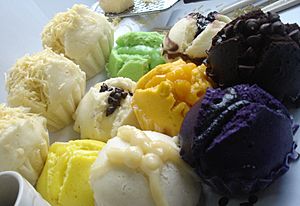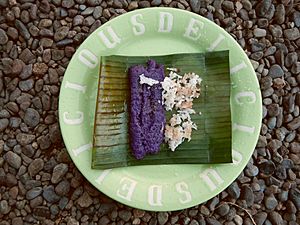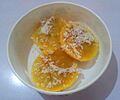Puto (food) facts for kids
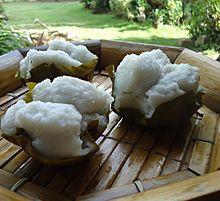
Puto in banana leaf liner
|
|
| Course | Dessert, breakfast |
|---|---|
| Place of origin | Philippines |
| Serving temperature | hot, warm, or room temperature |
| Main ingredients | Rice |
| 587 kcal (2458 kJ) | |
| Similar dishes | bibingka, panyalam, puttu, kue putu |
Puto is a popular Filipino rice cake. It is usually made by steaming a special rice dough. This dough is often slightly fermented, which gives puto its unique taste.
People enjoy puto on its own as a snack. It also goes well with many savory Filipino dishes. One famous pairing is with dinuguan, a rich stew. The word puto can also mean different kinds of steamed cakes from the Philippines. Some of these cakes are not even made from rice! Puto is a type of kakanin, which is a general term for Filipino rice cakes.
Contents
How Puto is Made
To make traditional puto, rice is soaked in water overnight. This helps it to ferment a little. Sometimes, Yeast is added to help this process along. The soaked rice is then ground into a smooth dough. This dough is called galapong. After preparing the galapong, the mixture is poured into molds and steamed.
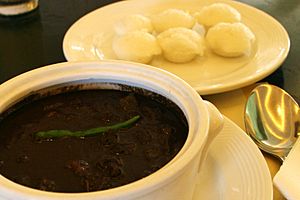
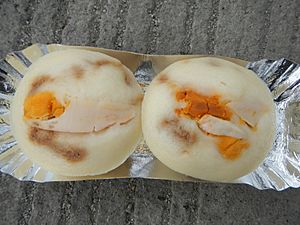
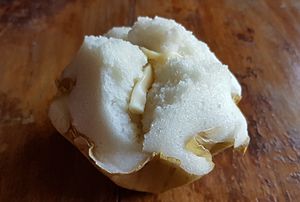
The steamers used for puto are usually round. They can be about 30 to 60 centimeters wide. These steamers are often made from metal or bamboo. The lid is usually cone-shaped. This design helps steam drip down the sides, not onto the cakes.
A thin cloth or a banana leaf is placed over the steamer. The puto batter is then poured onto it. Once cooked, puto is often sold as large, thick cakes. These are placed in flat baskets lined with banana leaves. You can buy them whole or sliced into smaller pieces.
Good puto has a light, yeasty smell from the fermented rice. It should be soft and moist, not sticky or crumbly. The main flavor is fresh rice. Sometimes, a little sugar is added if it's eaten as a sweet snack.
Puto is often enjoyed with different toppings. Common ones include cheese, butter, hard-boiled eggs, or fresh coconut. In some areas like Bulacan, puto with cheese is jokingly called putong bakla. Puto with egg is called putong lalaki (man's puto). Those with meat fillings are called putong babae (woman's puto).
Different Kinds of Puto
As mentioned, puto is a general name for many steamed cakes. They are usually made with some type of flour. This is different from bibingka, which are baked cakes. However, there are a few exceptions. For example, puto seko is a dry, baked cookie.
The traditional puto made from rice dough is sometimes called putong puti (white puto). It can also be called putong bigas (rice puto). This helps tell it apart from other dishes also named puto.
Today, you can find modern puto with new flavors. These might include ube (purple yam), vanilla, or chocolate. Here are some interesting types of puto:
Rice-based Puto
- Puto bao - This puto comes from the Bicol Region. It is traditionally cooked in halved coconut shells. These shells are lined with a banana leaf. It has a sweet filling made of sweetened coconut meat called bukayo.
- Puto bumbong – This special puto is made from a purple glutinous rice called pirurutong. The rice is soaked in saltwater and dried. Then, it is steamed inside bumbóng, which are bamboo tubes. It is served with butter and shredded coconut mixed with brown sugar. It is very popular during Christmas in the Philippines.
- Puto kutsinta - This steamed rice cake is similar to putong puti. It is made using lye, which gives it a moist and chewy texture. It can be reddish-brown, yellow, or orange. It is usually topped with shredded coconut.
- Puto Manapla – This puto is flavored with anise and lined with banana leaves. It is named after the town of Manapla where it began.
- Puto maya – This is a type of biko. It is made from glutinous rice soaked and steamed. Then, it is mixed with coconut milk, salt, sugar, and ginger juice. It is steamed again. This puto is popular in Cebuano-speaking areas. It is often eaten early in the morning with sikwate (hot chocolate) and ripe mangoes.
- Puto pandan – This puto is cooked with pandan leaves. The leaves give it a nice smell and a light green color.
- Puto-Pao – This is a mix of siopao (a meat-filled bun) and puto. It uses the traditional puto recipe but adds a spiced meat filling.
- Putong pula - This puto from the Rizal Province uses brown sugar. This gives it a brownish color.
- Putong pulo - These are small, round puto from Tagalog areas. They often use achuete seeds for coloring, making them light brown or orange. They are usually served with cheese or grated young coconut.
- Sayongsong – This puto is made from ground glutinous rice, regular rice, and young coconut or roasted peanuts. It also has coconut milk, sugar, and calamansi juice. It is special because it is served in cone-shaped banana leaves. It is a favorite in Surigao del Norte and the Caraga Region.
Other Types of Puto
- Puto flan (also called leche puto) – This is a combination of a steamed muffin and leche flan (a type of custard). It often uses regular flour, but some versions use rice flour.
- Putong kamotengkahoy - Also known as puto binggala in Visayan. This is a small cupcake made from cassava, grated coconut, and sugar. It is similar to cassava cake but is steamed instead of baked.
- Puto lanson – This puto from Iloilo is made from grated cassava. It has a foamy texture when cooked.
- Puto mamón – This puto does not use rice. It combines egg yolks, salt, and sugar with milk, water, and flour. Beaten egg whites are folded in. The dough is then steamed in muffin cups. It is a steamed version of mamón, a traditional Filipino chiffon cake.
- Puto seco – This is a dry, powdery cookie made from corn flour. Its name means "dry puto" in Spanish. It is baked, not steamed.
Images for kids
-
Large cheese puto from Bulacan.
-
Puto kutsinta topped with grated coconut.
-
Puto pandan infused with pandan leaves.
-
Puto flan, a combination of puto and leche flan.
-
Puto mamón, made with flour instead of rice flour.
-
Puto maya, a type of biko shaped into little patties.
See also
 In Spanish: Puto para niños
In Spanish: Puto para niños


